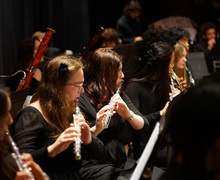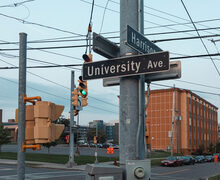SU will host classes, recreation in Carrier Dome during spring semester
Alex Malanoski | Staff Photographer
The Carrier Dome will host classes that require social distancing and movement, including some music and drama classes.
The Daily Orange is a nonprofit newsroom that receives no funding from Syracuse University. Consider donating today to support our mission.
After teaching a class of over 200 students online in the fall, Jeff Rubin knew he wanted to find a way to safely get back in front of a large in-person class.
Before the fall semester started, Rubin thought of using the Carrier Dome — the only space on campus that could accommodate social distancing for a large class — but knew it wouldn’t be available due to renovations. Now that construction is complete, Rubin, an associate professor of practice in Syracuse University’s School of Information Studies, will be using the Dome to teach his information technologies lecture.
“I taught my class online in the fall. It was great, it really did work, but you can’t replicate the in-person experience,” Rubin said.
Rubin has been working with staff at the Dome to prepare the space and test the technology he’ll be using. About 170 students will sit, socially distanced, in the stands while Rubin teaches from a makeshift stage on the field. He’ll use the new Jumbotron to present to his class.
But the Dome won’t only be used for classes. SU will also open the stadium to students throughout the spring semester, bringing in benches and other furniture to replicate the feeling of the Quad. In the fall, SU took advantage of the warm weather to host classes and other meetings outside in tents. The university is now looking to optimize large indoor spaces for similar academic and recreational purposes.
A lot of effort by many, but next week if all goes well, I will be teaching my Info Tech class in the @CarrierDome44 in front of ~150 @SyracuseU students. Lectures will be projected on the new video board.
How great that I get to look at Floyd Little's name every lecture! pic.twitter.com/b6BlSVunhK
— Jeff Rubin (@jhrubin) February 1, 2021
“Obviously, it’s too cold in the winter to be outside, so we’re trying to replicate that inside,” said Rob Hradsky, senior associate vice president for enrollment and the student experience.
SU officials are working to establish “recreation times” in the Dome so intramural sports teams can practice on the field, and they are considering ways to split the field up to allow multiple activities to occur at once, Hradsky said.
If New York state approves the university’s proposal to allow limited attendance at sporting events, the Dome could also be used to host large events, such as movie screenings, Hradsky said. SU has been working with its own COVID-19 response team and county health officials to ensure indoor spaces are safe for students, he said.
The Dome is a suitable alternative to outdoor space like the Quad and is safe for larger gatherings, as long as students continue to wear masks and socially distance, said Brooks Gump, a public health professor at SU’s Falk College.
“You still want to monitor for compliance with safety rules, but we really do need to start working creatively to come up with ways for students to interact safely,” Gump said. “Opening the Dome is a very creative way to allow for distance.”
Since the coronavirus can spread through the air, ventilation and open space are critical factors in assessing the risk for transmission, Gump said. In addition to expanding access to open indoor spaces, SU has also upgraded ventilation systems in many classrooms, he said.
Chris Johnson, associate provost for academic affairs, said SU is trying to make full use of all its facilities. The Dome will host classes that require social distancing and movement, including some music and drama classes, and the newly-renovated Schine Student Center is large enough to accommodate larger numbers of students while complying with public health guidelines.
“We are looking at every square inch that the university owns to be used for academic purposes, to be used for student experience purposes,” Johnson said. “It’s not like we’re holding back a few hundred thousand square feet. It’s really a matter of optimizing the use.”
SU also hopes students will take advantage of meeting spaces and private areas in its libraries, said David Seaman, dean of libraries. Spaces specifically designed for online classes, studying and group work are all available.
“We had plenty of spare capacity last fall, so we’re not worried about running out of space,” he said.
SU has already upgraded ventilation systems in its libraries, and staff will continue to use the cleaning procedures put in place for the fall semester, Seaman said.
We are looking at every square inch that the university owns to be used for academic purposes, to be used for student experience purposes. It’s really a matter of optimizing the use.Chris Johnson, Associate Provost for Academic Affairs
By delaying the start of the spring semester until Feb. 8, SU has also traded in two winter weeks for warmer weeks in May, Johnson said.
“I think we will have many more opportunities for students to be outdoors in spontaneous ways this spring semester than we have ever had in a spring semester just because we moved the calendar in the way that we did,” Johnson said.
Hradsky and Johnson said they are not worried about another campus shutdown, which occurred after a spike in cases two weeks before the end of the fall semester. SU will evaluate the prevalence of the virus on campus throughout the semester to consider easing some restrictions, they said.
“I think we’re very intentional about learning from the fall semester,” Hradsky said. “We believe that through mask wearing, social distancing, reducing density, that we can hold indoor activities safely.”
The university’s aggressive public health efforts played a much larger role in keeping campus open in the fall than warm weather or the ability to be outside, Gump said. But officials will need to closely monitor virus transmission this winter as students are forced indoors, especially as more transmissible variants of the virus emerge across the country, he said.
“It will be important to continue these efforts where you try to create spaces where students can safely be together, whether it’s Schine or the Dome, or well-ventilated classrooms,” Gump said.
Published on February 7, 2021 at 8:15 pm
Contact Sarah: scalessa@syr.edu | @sarahalessan






